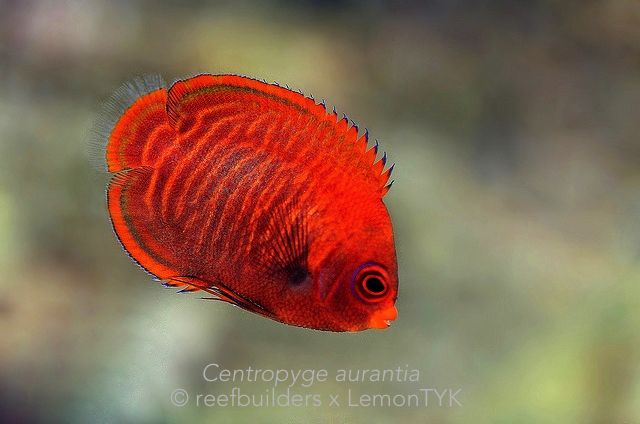All that glitters is not gold. That is certainly the case for Centropyge aurantia, the golden angelfish. Despite having both the common and latin name of this fish associated with the precious metal, there is in terms of appearance, very little going on to suggest this pairing. C. aurantia is a Western Pacific species with a scattered distribution that includes the American Samoa, Papua New Guinea, Solomon Islands, the northern Great Barrier Reefs, Caroline Islands as well as eastern Indonesia.
In this beautiful species, the ground colour is typically brick red to deep orange with a network of lighter coloured striae that may appear, as its name suggests, gold under certain angles and correct lighting. Perhaps this was where it got its name from. C. aurantia is unique in possessing very large eyes situated very near a tiny mouth. It has a rather high body profile so much so that when the fish erects all its fins, it may appear almost circular in shape.

C. aurantia is a painfully shy and coy species that is very rarely seen by divers. Richard Pyle described this fish as being a “ghost”, and in a Bishop Museum blog post he gave a recount of this species which he met and observed in Pohnpei. According to Richard, it seemed as though this highly cryptic fish became more active as the sun went down toward the evening.
Its sheepish and wary nature is only compounded by its preference for dense coral thickets, in which it spends most of its time cloistered and far away from divers. The golden angelfish like Centropyge nigriocella, is very seldom seen in the wild despite their shallow water nature. Usage of ichthyocides such as rotenone will reveal the presence of these species even if they were not encountered visually. Unfortunately because of their diffident qualities, many are caught with the usage of cyanide and other poisons, and this in turn makes for a doomed fish.
C. aurantia comes in two colour forms. The usual brick red-orange above, and a ferruginous brown form that come out from Sulawesi and the Solomon Islands. Apart from the ground colour, this brown form bears the same orange ripples that adorn the body and the same reclusive disposition. The fish is moderately difficult to keep in the home aquaria and is often too shy to venture out for food. With patience and initial pampering, healthy net caught specimens of this fish do survive well and can live for a long time. Unfortunately, their behaviour in the wild transcends to the home aquariums as well, and in a reef tank you’re only likely to encounter this fish as a ghostly apparition.



